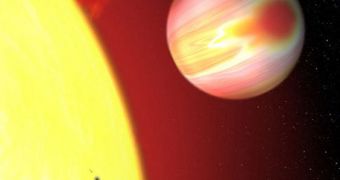A team of astronomers was recently able to conduct a groundbreaking analysis on the atmosphere of a particular exoplanet, which they managed to image in several wavelengths, using various filters.
This is unfortunately rather uncommon for exoplanetary research, given the vast distances that exist between Earth and any of the 500+ extrasolar planets discovered thus far.
Usually, even the most advanced telescopes use a single color filter when it comes to studying distant star systems in search of a planet, and the end result that experts get is a colorless smudge on images.
One of the reasons why this is very limiting is because colors hold a great deal of information when it comes to studying space and the objects it contains, Universe Today reports.
Chemists can identify the chemical composition of a star using nothing but its light and can also analyze a planet's atmosphere by looking at the polarization of the light it reflects.
Analyzing the polarization of reflected starlight was the goal of the study, details of which appear in a new research paper. Experts say that this allowed them to figure out some of the characteristics of an exoplanet’s atmosphere.
For the investigation, experts selected the exoplanet HD189733b, which was observed using the UBV filters system. It contains separate filters for ultraviolet, blue, and green wavelengths, scientists say.
The system exploits the fact that light gets polarized in specific patterns when reflected. This is clearly visible in polarized sunglasses, which block light that produces glares on the road.
This is made possible by the fact that most roads produce glares at certain wavelengths, which the glasses eliminate from view. The exact same principle holds true for space studies as well.
Depending on the composition of an atmosphere, light bouncing off it will get polarized in certain ways, and existing scientific instruments can make out the set of chemicals that triggers a specific type of polarization.
The new investigation was conducted using the Nordic Optical Telescope, in Spain. But the team that conducted the work acknowledges that this study technique still has some limitations.
Though the results can withstand rigorous verification, there is still a high degree of uncertainty associated with them. Some may argue that it's difficult to tease out pertinent readings about an exoplanet from all the background noise.
However, experts hope that improvements in this observations technique might allow for it to be more widely accepted in the international astronomical community soon.

 14 DAY TRIAL //
14 DAY TRIAL //